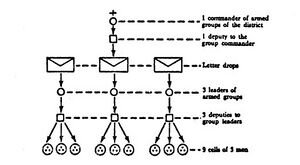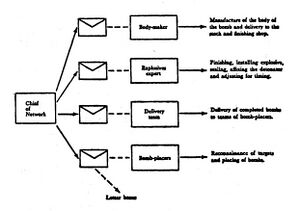| Part of a series on |
| Counterinsurgency |
|---|
3. An Example of a Clandestine Warfare Organization (Modern Warfare)
hat operating in the city of Algiers during 1956-57. It was constituted as an autonomous zone by the National Liberation Front (F.L.N.), but was related to the F.L.N. setup throughout Algeria.
The Autonomous Zone of Algiers (Z.A.A.) operated under a council of four members: a political-military leader, a political assistant, a military assistant, and an assistant for external liaison and intelligence. Decisions were made in common, but the vote of the political-military leader counted heaviest.
The city and its suburbs were divided into three regions —Central Algiers, Algiers West, and Algiers East—which operated under regional councils identical to the zonal council. Each region was divided into sectors, which, in turn, were subdivided into districts. In all, the Z.A.A.'s three regions comprised ten sectors, or thirty-four districts.
three regions comprised ten sectors, or thirty-four districts. The organization of the Z.A.A. contained two distinct elements: the National Liberation Front (F.L.N.), or political arm, and the National Liberation Army (A.L.N.), or military arm. Both were integrated into the same geographical breakdown, but were highly compartmented and were united only at the regional and zonal levels.
Units of the A.L.N. and F.L.N. worked side by side in each district, but the regional council was responsible for coordination of their action.
The political organization (F.L.N.) of each districtbased on the demi-cell of three men, then the cell, the demi-group, the group, and the sub-district—was under the command of a district leader, who controlled 127 men (see the table below).
| Demi-Cell | Cell | Demi-Group | Group | Sub-District | District |
|---|---|---|---|---|---|
|
2. Demi-Cells plus a Cell Leader | 2 Cells plus a Demi-Group Leader | 2 Demi-Groups plus a Group Leader | 2 Groups plus a Sub-District Leader | 2 Sub-Districts plus a District Leader |
| 3 men | 7 men | 15 men | 31 men | 63 men | 127 men |
The military organization (A.L.N.) of the district consisted of 35 armed men. The district commander and his deputy were at the head of three armed groups, each headed by a leader and deputy and composed of three cells of three men each.
(The political organization had at its disposal some armed shock groups of its own that were not part of the A.L.N.; they constituted the F.L.N/S "police" and were charged with the execution of sentences pronounced by their judiciary.)
The zonal council assistant for external liaison and intelligence had at his disposal a certain number of committees in which were grouped the F.L.N/s intellectuals. The following were the principal committees and their duties.
• Liaison Committee—maintained contact with the wilayas, or major military districts (Algeria was divided by the F.L.N. into six wilayas); with the Committee for External Coordination (C.C.E.), forerunner of the present Provisional Government of the Algerian Republic (G.P.R.A.); and with the Exterior; Tunisia, Morocco, France.
• Information Committee—at that time the embryo of the special services. • Editorial Committee—maintained United Nations dossiers, "reprisal" dossiers, relations with the intellectuals, documentation for the French and other foreign press, etc.
• Justice Committee—general surveillance of French citizens of Moslem origin (F.M.A.); judged cases between Moslems in civil and criminal law, imposed various fines, etc.
• Financial Committee—gathered funds from the population at large, using units of the F.L.N., and, in larger amounts, directly from big companies, banks, leading merchants, etc.
• Health Committee—embryonic in Algiers. The sick and wounded were mostly cared for in secret in the hospitals of the city.
• Trade Union Committee—maintained permanent contact with various syndical organizations, such as the General Union of Algerian Workers (U.G.T.A.) and the General Union of Algerian Merchants (U.G.C A.).
A final important element of the whole Z.A.A. organization was the bomb-throwing network directly responsible to the zonal council. Carefully kept apart from other elements of the organization, the network was broken down into a number of quite distinct and compartmented branches, in communication only with the network chief through a system of letter boxes. A chart of the organization of the bomb-throwing network is shown below.
In the city of Algiers alone, the clandestine warfare organization comprised approximately 1,200 armed men (A.L.N.), and 4,500 persons unarmed or semiarmed (F.L.N.). At that time, there were scarcely a thousand police, equipped only to fight common criminals in time of peace. Taken by surprise by an adversary of which it was totally ignorant, the police had no chance of coming out on top. The army's intervention was therefore unavoidable.
A clandestine organization of such size and complexity requires for its creation both time and a precise technique. The higher cadres, up to regional level, had all received a more or less thorough Marxist training; they had entered the organization voluntarily.
The lower cadres and the rank-and-file were at first recruited from the seamier elements of the city, delinquents or habitual criminals. By the very fact of their pasts, they were already quite well adapted to the missions they were going to be assigned.
Later on, the organization received a constant influx of new members which kept up or augmented its forces. The manner in which they were recruited has been revealed to us through numerous interrogations. To the question "How did you enter the A.L.N.?"—which was often put to them—most of the young terrorists replied:
"I was a good worker and was earning an honest living. One day, I was stopped by a fellow who insisted I pay a certain sum to the F.L.N. At first I refused, and*was beaten up by the three men he had with him. I paid. The next month the same sum was asked. I paid it without argument. Some time later, I became a collector myself. I re* ceived a list of persons who were to contribute and a small armed team to protect me during the collection. Then, as I was athletic and in good health, I was asked to enter into the armed organization—the A.L.N.—the Army of National Liberation. I wanted to refuse, but a few pointed threats made me accept. From that time on I was lost, because to be admitted to the A.L.N., one first had to prove his worth; that is, to carry out an armed attack in the city. The con* ditions under which this was to be accomplished were explained to me. One evening, at a fixed time and an appointed place, an individual unknown to me was to give me a loaded weapon with the mission to kill the first person I came across. I was then to flee, dropping the weapon into a trashcan that the unknown person had pointed out to me. I did what was required of me and, three days later, I entered as a member into a cell of the A.L.N."
It was in this manner in the month of January, 1957, that Doctor X of Algiers was assassinated by a young man who did not even know the name of his victim.
The means of putting pressure on the citizenry were quite varied. The following is an example of one used by the members of the zonal council to assure their own security:
When one or several members of the council wanted to install themselves in a house in the Casbah, they first sent a team of masons to construct a hiding place there. The masons immediately gathered together the people in the building and told them, in substance: "You are soon to receive important personages. You will be responsible for their security with your lives." And sometimes, to indicate that this was no idle threat, a burst of gunfire cut down on the spot the residents who seemed to them most suspect From then on, the movements of the residents were strictly controlled; never could more than half of them be outside at a time. The secret was well kept.
Yassef Saadi, political-military commissar of the Z.AA. was able to install himself within 200 yards of the office of the army commandant of the Algiers sector and remain there without being found for several months before his arrest.

